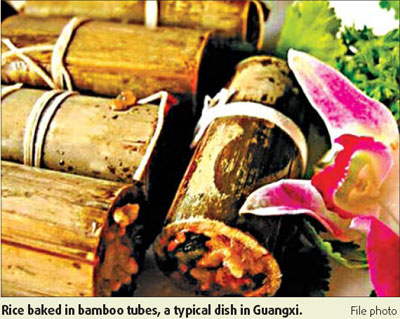Guangxi goodness
One of the great pleasures of traveling around China is coming across unfamiliar ingredients and unusual cooking techniques.
This was certainly the case on my recent Guangxi trip to the areas of Longji and Yangshuo, in south China.
First, there was rice baked in bamboo tubes (zhu tong fan), which we discovered in a tiny rice terrace village of Ping'an. We had followed the aroma of charred bamboo wood wafting from a barbecue on a back lane.
For this dish, a mature bamboo tube is stuffed with glutinous rice and varying combinations of smoked sausage, pork, chicken and taro. Water is added and the tube sealed with a cork made from what appears to be a corncob. Once cooked, the top of the tube is lifted to reveal the chewy, smoke-scented rice.
My favorite new veggie dish of the trip was stir-fried young bamboo shoots.

I was expecting the pale yellow shoots (zhu sun) familiar to me from Beijing. Instead, we received a plate of vibrant green stalks (sun), very tender and absolutely delicious. Apparently, they are coming into season now across the country, so they are definitely worth looking out for at the market - they make an excellent substitute to the pricier asparagus.
On our first afternoon following a steady ascent of the rice terraces, we were enticed to try some luo han guo and ginger tea, which was guaranteed to soothe sore throats. Having left the smog of Beijing the previous evening, my throat had actually never felt better. Nevertheless, this sweet and fragrant tea was lovely.
Luo han guo literally means "monk's fruit". The fruit grows on vines to a size just smaller than a tennis ball. Normally, they are not eaten fresh but dried until leathery brown in the oven, and used frequently in traditional Chinese medicine for respiratory problems.
Interestingly, the extract of the fruit is said to be 300 times sweeter than sugar, and has been used for centuries as a low-calorie sugar substitute in China.
The fertile winding rivers of Guangxi are home to many types of freshwater fish and we took full advantage of this.
Yangshuo's local specialty is Beer Fish (pijiu yu), which was particularly delicious as we lunched on a wooden terrace perched on the Yulong River, following a rather muddy morning cycle.

I was delighted to learn that this is a relatively simple dish to re-create. It is a sure winner at home (the alcohol from the beer evaporates during cooking, so it is fine for children and drivers alike).
To cook it: Take any freshwater white fish, slice open along the bottom and score the flesh. Fry on either side in a small amount of peanut oil until golden brown. Add sliced red and green peppers, two sticks of sliced celery, one sliced chili pepper, a few cloves of chopped garlic and an equivalent amount of ginger.
Pour in 300 ml of local beer until it covers the fish. Bring this to boil and add a pinch each of sugar, white pepper and salt, and a teaspoon of oyster and soy sauce. Cook for five minutes, then add two chopped tomatoes and turn the fish over.
Mix a pinch of cornstarch in half a cup of water. After three minutes, add this to the wok along with some chopped spring onion and a few drops of sesame oil.
Cook for two more minutes before serving it with rice and something leafy, such as amaranth (xian cai) or Shanghai pak choi (qing cai).
This nutrition-related column is written by Nina Lenton, a qualified dietitian living and working in Beijing. Contact her at nina_lenton@hotmail.com.
(China Daily 05/28/2008 page19)














